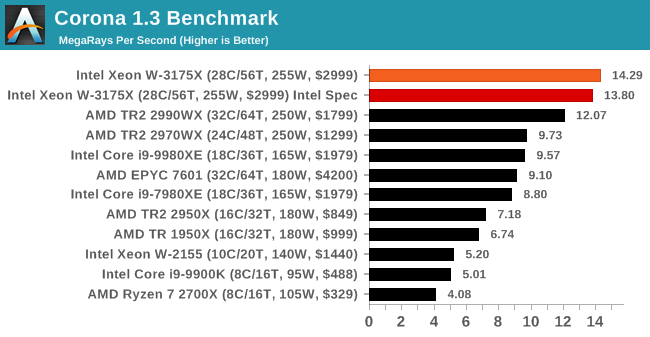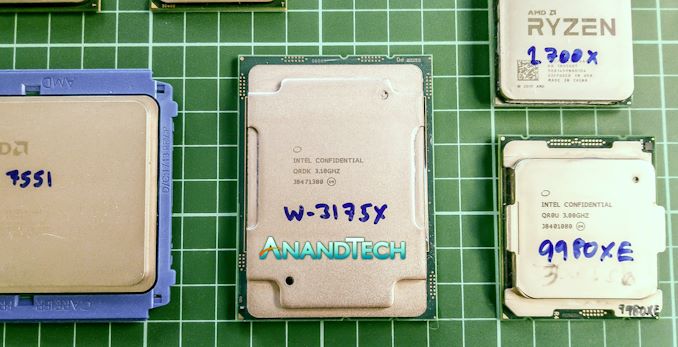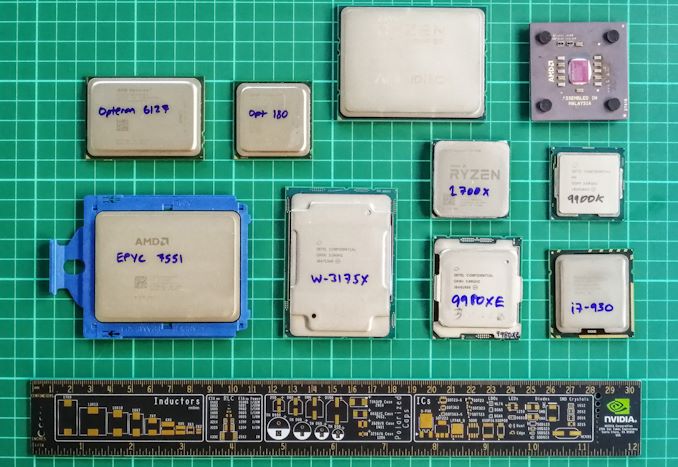The Intel Xeon W-3175X Review: 28 Unlocked Cores, $2999
by Ian Cutress on January 30, 2019 9:00 AM ESTConclusion: Price Makes Perfect
When you buy a system, ask yourself – what matters most to you?
Is it gaming performance?
Is it bang-for-buck?
Is it all-out peak performance?
Is it power consumption?
Is it performance per watt?
I can guarantee that out of the AnandTech audience, we will have some readers in each of these categories. Some will be price sensitive, while others will not. Some will be performance sensitive, others will be power (or noise) sensitive. The point here is that the Xeon W-3175X only caters to one market: high performance.
We tested the Xeon W-3175X in our regular suite of tests, and it performs as much as we would expect – it is a 28 core version of the Core i9-9980XE, so in single threaded tests it is about the same, but in raw multi-threaded tests it performs up to 50% better. For rendering, that’s great. For our variable threaded tests, the gains are not as big, from either no gain at all to around 20% or so. This is the nature of increasing threads – at some point, software hits Amdahl’s law of scaling and more threads does nothing. However, for software that isn’t at that point, the W-3175X comes in like a wrecking ball.

For our graphs, some of them had two values: a regular value in orange, and one in red called 'Intel Spec'. ASUS offers the option to 'open up' the power and current limits of the chip, so the CPU is still running at the same frequency but is not throttled. Despite Intel saying that they recommend 'Intel Spec', the system they sent to us to test was actually set up with the power limits opened up, and the results they provided for us to compare to internally also correlated with that setting. As a result, we provided both sets results for our CPU tests.
For the most part, the 'opened up' results scored better, especially in multithreaded tests, however Intel Spec did excel in memory bound tests. This is likely because in the 'opened up' way, there is no limit to keeping the high turbo which means there could be additional stalls for memory based workloads. In a slower 'Intel Spec' environment, there's plenty of power for the mesh and the memory controllers do deal with requests as they come.
Power, Overclockability, and Availability
Two-and-a-half questions hung over Intel during the announcement and launch of the W-3175X. First one was power, second was overclockability, and two-point-five was availability.
On the power side of the equation, again the W-3175X comes in like a wrecking ball, and this baby is on fire. While this chip has a 255W TDP, the turbo max power value is 510W – we don’t hit that at ‘stock’ frequency, which is more around the 300W mark, but we can really crank out the power when we start overclocking.
This processor has a regular all-core frequency of 3.8 GHz, with AVX2 at 3.2 GHz and AVX-512 at 2.8 GHz. In our testing, just by adjusting multipliers, we achieved an all-core turbo of 4.4 GHz and an AVX2 turbo of 4.0 GHz, with the systems drawing 520W and 450W respectively. At these frequencies, our CPU was reporting temperatures in excess of 110ºC! This processor is actually rated with a thermal shutoff at 120ºC, well above the 105ºC we see with regular desktop processors, which shows that perhaps Intel had to bin these chips enough that the high temperature profile was required.
On the question of availability, this is where the road is not so clear. Intel is intending only to sell these processors through OEMs and system integrators as part of pre-built systems only, for now. We’ve heard some numbers about how many chips will be made (it’s a low four-digit number), but we can only approximately confirm those numbers given one motherboard vendor also qualified how many boards they were building.
One of Anand’s comments I will always remember during our time together at AnandTech was this:
“There are no bad products, only bad prices.”
According to OEMs we spoke to, initially this processor was going to be $8k. The idea here is that being 28-core and unlocked, Intel did not want to consume its $10k Xeon market. Since then, distributors told us that the latest information they were getting was around $4500, and now Intel is saying that the recommended consumer price is $3000. That’s not Intel’s usual definition of ‘per-1000 units’, that’s the actual end-user price. Intel isn’t even quoting a per-1000 unit price, which just goes to substantiate the numbers we heard about volume.
At $8000, this CPU would be dead in the water, only suitable for high-frequency traders who could eat up the cost within a few hours of trading. At $4500, it would be a stretch, given that 18-core on Intel is only $2099, and AMD offers the 32-core 2990WX for $1799 which surpasses the performance per dollar on any rendering task.
At $2999, Intel has probably priced this one just right.
At $2999, it's not a hideous monstronsity that some worried it would be, but instead becomes a very believeable progression from the Core i9-9980XE. Just don’t ask about the rest of the system, as an OEM is probably looking at a $7k minimum build, or $10k end-user shelf price.












136 Comments
View All Comments
Yorgos - Wednesday, January 30, 2019 - link
I don't know what's more delusional, Intel selling a 500Watt CPUor fanboys thinking that this product will sell well at $3000.
Listen buddy, most sales from these systems come from Dell, HP and/or Lenovo workstations.
Nobody is going to bother messing with a cpu that's a fire hazard, gives you the same PCI-e lanes as a $300 CPU and you are obliged, as Dell/HP/Lenovo, to buy special motherboards from asus or another manufacturer.
Finally, the product placement here from Purch media targets Gamers, plus intel targets gamers.
This is just a shelf product, just like 8700k and 9900k to fight for the first position in some benchmarks, against zen, due to the unfortunate circumstances of zen being that good.
This product takes binned cpus away from much higher priced Xeons. They are not going to make great numbers available, by default, even if they could supply the market.
eddman - Wednesday, January 30, 2019 - link
"delusional", "fanboys", "Listen buddy", "fire hazard"You don't have to get so emotional to make a point.
Yorgos - Wednesday, January 30, 2019 - link
I like my comments to be vivid.I don't write NPC comments.
Arbie - Wednesday, January 30, 2019 - link
Then you should move to somewhere like Wccftech, where you won't even have to rationalize picking fights and being gratuitously rude. People like you ruin the tone of a quality forum.eddman - Wednesday, January 30, 2019 - link
Being vulgar and crass isn't the same as being "vivid". If you cannot reply without resorting to name calling, then this not the place for you.WasHopingForAnHonestReview - Wednesday, January 30, 2019 - link
What part of his comment insulted you, snowflake?eddman - Wednesday, January 30, 2019 - link
I didn't say he's not right.None. The point is this is a tech site. There is no need for such remarks.
"Snowflake"
This is what I'm talking about. Randomly calling people names with no reason. You don't even know me.
PeachNCream - Thursday, January 31, 2019 - link
I've run a lot of paper and pencil RPGs over the years and I'm disappointed to say that a number of my cookie cutter NPCs had more personality than some of the player characters, but I'm one of those story first GM types.WasHopingForAnHonestReview - Wednesday, January 30, 2019 - link
Buzzwords or not the man is right.BGADK - Wednesday, January 30, 2019 - link
You have no idea what professional software costs. In the end my clients dont care if the PC costs 5000USD, 7000 USD or 12000USD.The difference disapear when you add the software costs and my fee.